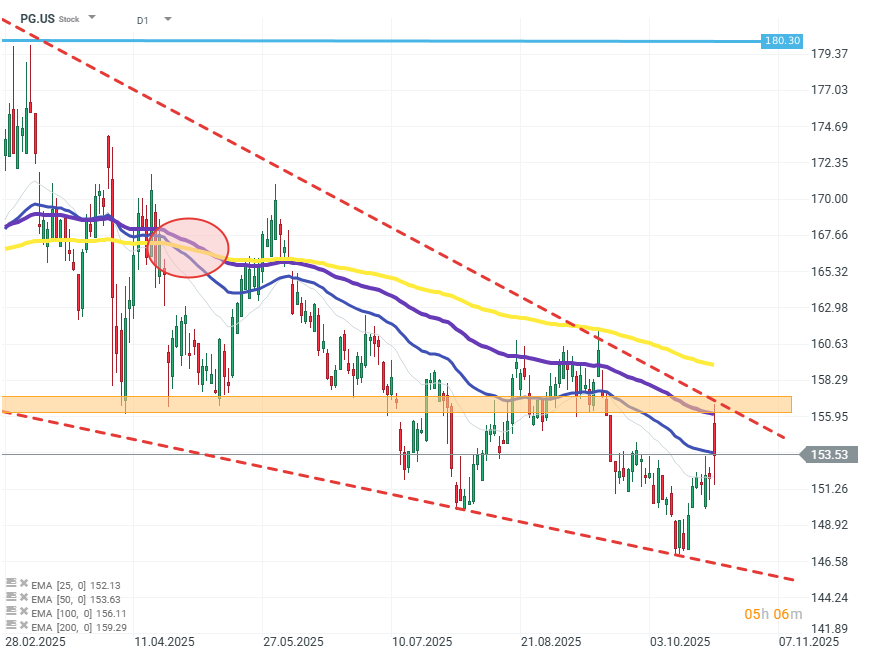- P&G recorded a moderate sales and revenue growth
- Gross margin fell by 50 basis points
- The company maintained cost discipline
- The sales volume across the entire group remained neutral
- P&G recorded a moderate sales and revenue growth
- Gross margin fell by 50 basis points
- The company maintained cost discipline
- The sales volume across the entire group remained neutral
Procter & Gamble is an American giant in the fast-moving consumer goods sector with a portfolio of global brands. It is one of the largest companies in the consumer industry and is recognized as one of the so-called Dividend Kings. The latest results published by the company before today's session confirm a slow yet stable growth in sales and profits. The company's shares are up about 2% in today's session.
P&G recorded a moderate organic sales growth of 2% year-over-year, with zero impact from volume and positive contributions from both pricing and sales structure. This indicates stable demand. The sales volume across the entire group remained neutral year-over-year, and revenue growth was primarily driven by pricing policy and product assortment. This suggests a still cautious attitude among some consumers, especially in categories more sensitive to promotions.
Financial Results Q1FY2026:
- Total revenue increased by 3% to $22.4 billion.
- Adjusted earnings per share rose by 3% to $1.99.
- "Diluted" earnings per share increased by as much as 21% to $1.95, due to the base effect from the previous year.
- Gross margin fell by 50 basis points year-over-year, mainly due to unfavorable sales structure, brand reinvestments, and higher costs of tariffs and raw materials.
- The beauty segment grew organically by 6% thanks to innovations and strong sales of premium products in hair and skin care. The shaving segment increased organic sales by 3%, and baby products benefited from both better sales structure and higher volumes.
- However, the picture of product categories remains uneven. In fabric care, there was a decline in volumes, particularly in Europe. In home maintenance products, revenue growth was mainly driven by prices, with declining volumes. In household paper products, there was a decline, partly due to intensive promotions.
- The company maintained cost discipline: selling and general administrative expenses as a percentage of revenue fell by 40 basis points year-over-year.
- Operating cash flow amounted to $5.4 billion, and the "Productivity" free cash flow ratio reached as high as 102%.
- The total amount returned to shareholders reached $3.8 billion ($2.55 billion in dividends and $1.25 billion in share buybacks).
Forecasts
The company maintained its full-year forecasts, which is particularly important for investors. Organic sales growth is expected to be up to 4%, total sales 1-5%, and adjusted EPS also up to 4%. The average of these assumptions implies about 2% growth, confirming a cautious but stable scenario for the fiscal year and aligning with the results from the last quarter.
The results for the entire fiscal year will additionally be burdened by tariff costs estimated by the company at about $400 million after tax and higher raw material prices at about $100 million after tax. The total impact of these factors is about 19 cents per share on the downside.
In the coming quarters, key will be the rebound in volumes, especially in Europe and in fabric care and home maintenance products, as well as the effectiveness of reinvestments in demand. Maintained forecasts and likely favorable currency exchange impacts create a certain safety cushion, but achieving the upper range of assumptions will require improved demand dynamics and continued delivery of operational savings.
PG:US (D1)

Source: xStation5
US OPEN: US500 tests record highs as technology sector leads gains
Zelensky set to meet Trump on Sunday: A renewed hope for a breakthrough?
Chart of the day - Silver (26.12.25)
Morning wrap (26.12.2025)


